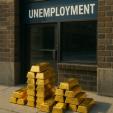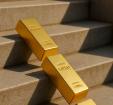Gold Prices 1971 – 2014 In 3 Waves
Ignore the hype regarding gold, bonds, booms and busts, hope and chains, “shock and awe,” stock market crashes, “money honey” commentary, and ignore the politicians. Don’t obsess over High-Frequency-Trading and market manipulation. Instead, focus on the big picture as shown in the following chart of monthly gold, which has been divided into 3 phases since 1971.

Phase 1: Gold rallied from about $42 in 1971 to over $800 in 1980, thanks to massive money printing, debts, deficits, wars, and a loss of confidence in the US dollar.
Phase 2: Gold prices crashed subsequent to the bubble of 1979-80, and then drifted lower for about 20 years. It double bottomed in 1999 and 2001.
Phase 3: Gold rallied off the 2001 low of about $255 to over $1,900 in August 2011. Since then it has corrected to under $1,200, and double bottomed in June and December 2013. Current price is about $1,300.
How Will Gold Prices Change in the next 3 – 5 Years?
Option 1: Gold prices will continue rising, erratically of course, within the green “megaphone” pattern shown above. In my opinion this option is the most likely unless we descend into a global deflationary depression and/or nuclear winter, which the politicians and bankers will do “whatever it takes” to avoid.
or
Option 2: Gold prices continue falling much like they did subsequent to the 1980 bubble high. I consider this option unlikely.
What Else Supports Option 1 – Higher Prices?
1) The rally into 2011 does not resemble the parabolic bubble blow-off into 1980. The drop in prices since 2011 looks like a correction, not a post-bubble crash. Gold was not in a bubble in 2011.
2) Interest rates today are practically zero, but in the 1980 crash era US rates were at all-time highs. Economic conditions are quite different.
3) Monetary policy today is extremely loose, but in 1980 era it was, relatively speaking, tight.
4) The stock market in 1980 had been declining or flat for over a decade, while the stock market of today has enjoyed over 5 years of practically continuous rally.
5) In 1980 confidence in the US dollar and the financial system was fragile, while today it seems (perhaps undeservedly) much stronger.
6) Technical indicators (see graph below) suggest that long-term gold prices have been bottoming during the past year. Note the other examples of “over-sold” conditions in gold prices.

What Else Supports Option 2 – Lower Prices?
1) Various self-serving forecasts from investment and bullion banks suggest lower prices – at least until they have sufficiently loaded up on future contracts and can massively profit from the rally ahead. I remain skeptical of such prognostications.
2) The price chart shows that gold has been falling since 2011. Some people believe it will continue falling for another 10 – 20 years. However, with ever increasing debt, bond monetization, food and energy inflation, massive Chinese and Russian purchases, and increasing political instability, lower prices appear to be an unlikely outcome.
3) The Fed and most other western central banks would like stable or lower gold prices, so their unbacked debt based paper currencies appear less weak. Maybe they can manufacture another decline in the gold prices such as during April – June 2013, but that also seems unlikely.
CONCLUSIONS:
This is not 1979 or 1980 when political and economic conditions were drastically different. Perhaps a better analogy would be about 50 years ago (1964) when the Vietnam War was escalating, US citizens were angry and marching in the streets, a gallon of gasoline cost 25 cents, coffee in a restaurant cost ten cents, and a decent middle-class wage was $2.50 per hour. The subsequent 20 years were life-changing and financially difficult for many people. Consumer prices increased drastically, the purchasing power of savings was destroyed, and people lost confidence in government and the US dollar.
Gold prices will rally much higher in the next 5 years. Jim Sinclair’s initial target of $3,500 seems very likely by 2016 – 2019. If the powers-that-be choose hyperinflation to deal with their massive debts, then much higher prices are “in play.”
There are many other options. For example, if you don’t trust or like gold, a bank will pay you 1% interest each and every year if you invest in a Certificate of Deposit.
GE Christenson
The Deviant Investor


















